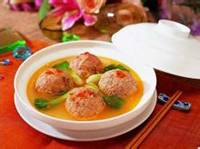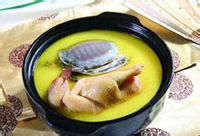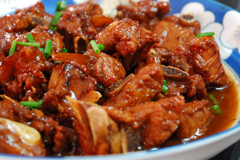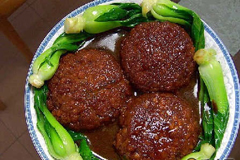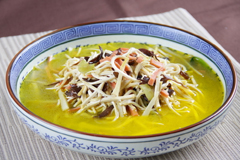
Jiangsu cuisine, abbreviated to Su cuisine, is one the Eight Culinary Traditions of Chinese cuisine.
| | It is derived from the native cooking styles of Jiangsu province. In general, Jiangsu cuisine's texture is characterised as soft, but not to the point of mushy or falling apart. For example, the meat tastes quite soft but would not separate from the bone when picked up. Other characteristics includes the strict selection of ingredients according to the seasons, emphasis on the matching colour and shape of each dish and emphasis on using soup to improve flavour. |
-------------------------------------------------------------------------------------------------------------------------------------------------------------------------
Regional Variations
| | Jiangsu cuisine is sometimes simply called Su cuisine, and one of its major styles is Huaiyang cuisine. Although Huaiyang cuisine is one of several sub-regional styles within Jiangsu cuisine, it is widely seen in Chinese culinary circles as the most popular and prestigious style of the Jiangsu cuisine. To a point where it is considered to be amongst one of the four most influential regional schools that dominate the culinary heritage of China, along with Cantonese cuisine, Shandong cuisine and Sichuan cuisine. |
Jiangsu cuisine actually consists of several other styles, including:
| Cuisine | Description |
| Nanjing | Its dishes emphasize an even taste and matching colour, with dishes incorporating river fish/shrimps and duck. |
| Suzhou | Emphasis on the selection of material, stronger taste than Nanjing cuisine, and with a tendency to be sweeter than the other varieties of the cuisine. |
| Wuxi | Its proximity to Lake Tai means it is notable for wide variety of freshwater produce, such as the "Three Whites" - white bait, white fish and white shrimp |
-------------------------------------------------------------------------------------------------------------------------------------------------------------------------
Features
- Distinguished for exquisite ingredients, freshness and aliveness.
- High cutting techniques.
- Have a good command of duration and degree of heating and cooking.
- Good at keeping the original taste one particular taste for one dish. All dishes have light, mellow and refreshing tastes. Yangzhou Cuisine is light and elegant; Suzhou Cuisine is slightly sweet; and Wuxi Cuisine is fairly sweet.
- Pay great attention to soup, which is strong but not greasy, and delicious
-------------------------------------------------------------------------------------------------------------------------------------------------------------------------
Foods
| Braised spare ribs |
|
| | Known for its melt-in-mouth texture and sweet taste. In Wuxi, the common cooking method is characterised by the addition of sugar and soy sauce to many savoury dish often in the form of hongshao. This often results in a fragrant, caramelised flavour. |
| Lion's head braised with crab-powder |
|
| | There is a metaphor in the dish name. In actual fact the Lion's head is a conglomeration of meat that is shaped like a sunflower and resembles a lion's head. It can be braised in a clear soup, or be red-cooked in a dense soup. A seasoning of crab powder enhances the flavor. |
| Boiled dry thread of Tofu |
|
| | Thanks to the exquisite skill of the chefs, the Tofu can be cut into very thin threads which have chances to absorb the savor of soup. When chicken pieces added to the soup, the dish is called 'chicken dry thread'; likewise, when shrimp added, it makes 'shrimp dry thread'. |
Written by Nicolas Yang
